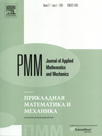 | | Journal of Applied
Mathematics and Mechanics
Russian Academy of Sciences | | Founded
in January 1936
(Translated from 1958)
Issued 6 times a year
ISSN 0021-8928
(print version) |
Archive of Issues
| Total articles in the database: | | 10610 |
| In Russian (ÏÌÌ): | | 9811
|
| In English (J. Appl. Math. Mech.): | | 799 |
|
| << Previous article | Volume 74, Issue 6 / 2010 | Next article >> |
| V.F. Koshelev and A.M. Lin’kov, "Numerical modelling of regular structures with randomly perturbed structural elements," J. Appl. Math. Mech. 74 (6), 735-744 (2010) |
| Year |
2010 |
Volume |
74 |
Issue |
6 |
Pages |
735-744 |
| Title |
Numerical modelling of regular structures with randomly perturbed structural elements |
| Author(s) |
V.F. Koshelev (St Petersburg, Russia, vadimkoshelev@yandex.ru)
A.M. Lin’kov (St Petersburg, Russia, linkoval@hotmail.com) |
| Abstract |
The problem of the effective elastic properties of regular composites with randomly perturbed geometric and mechanical parameters is formulated and solved numerically. Mean sample values and standard deviations of compliances are used to characterize the elastic properties. Compliance data are obtained by solving reduction problems for each of a set of realizations of random perturbations, and here the number of realizations is increased until the values of the statistical means become stable (within a given tolerance). Calculations for each realization are carried out by numerical solution of the complex hypersingular boundary integral equations obtained for a doubly periodic structure. The principal cell of this structure, containing a fairly large number of perturbed elements, is identified with a representative volume when a further increase in the number of perturbed elements do not alter the statistical means (again, within a given tolerance). Calculations are carried out for square and triangular grids with different densities of circular inclusions or holes, the centre coordinates of which are given random perturbations (weak, medium and strong). The results of the calculations are summed up in tables showing the effective compliances with an accuracy to at least three significant digits. An analysis of the values obtained for the holes shows’ that, with a tolerance of 5%, the principal cell of a square grid with four holes determines the representative volume for all the geometric parameter combinations investigated. For rigid inclusions this cell is the representative volume at a considerably greater tolerance than for compliant inclusions (4% as against 0.9%). Data on the effective properties of perturbed structures indicate that the difference between their compliance and that of the initial regular structures depends substantially on the relative stiffness of the inclusions. It is most marked for holes and rigid inclusions (9.5 and 12.6% respectively). It is established that, for a square grid, random perturbations have a stronger effect on the normal components of the compliance than on the shear component, and the opposite for a regular triangular grid - perturbations have a greater effect on the shear compliance. Calculations also show that symmetrical perturbations of holes (rigid inclusions) along one of the coordinates lead to a marked increase (reduction) in compliance in the orthogonal direction. The established dependence of the additional effective compliance on the amplitude of the perturbation enables the inverse problem to be solved: to find the parameters of the perturbed structure using data on its effective statistical properties. |
| Received |
05 March 2009 |
| Link to Fulltext |
|
| << Previous article | Volume 74, Issue 6 / 2010 | Next article >> |
|
 If you find a misprint on a webpage, please help us correct it promptly - just highlight and press Ctrl+Enter If you find a misprint on a webpage, please help us correct it promptly - just highlight and press Ctrl+Enter
|
|

 Russian
Russian  English
English